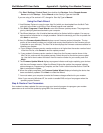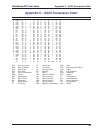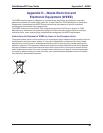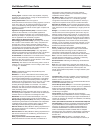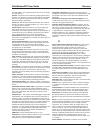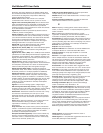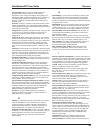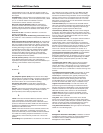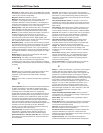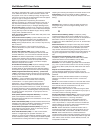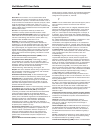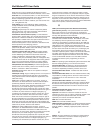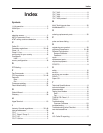
Glossary
41
MultiModemZPX User Guide
Megacom: An AT&T service with a normal WATS line (typically
T1) between the customer premise and the AT&T serving class
4 CO are the customer’s responibility.
MegaLink: BellSouth’s leased T1 service.
Message: Associated with such terms as packet, frame, and
segment. 1. In information theory, an ordered series of
characters intended to convey information. 2. An assembly of
characters and sometimes control codes that is transferred as
an entry from an originator to one or more recipients.
Message Pipe: A pipe that transfers data using a request/data/
status paradigm. The data has an imposed structure which
allows requests to be reliably identified and communicated.
Modem: A communications device that enables a computer to
transmit information over a phone line. It converts the
computer’s digital signals into analog signals to send over a
phone line and converts them back to digital signals at the
receiving end. Modems can be internal and fit into an expansion
slot, or external and connect to a serial port.
Multiplexer (Mux): 1. A device that takes several input signals
and combines them into a single output signal in such a manner
that each of the input signals can be recovered. 2. A device
capable of interleaving the events of two or more activities or
capable of distributing the events of an interleaved sequence to
the respective activities. 3. Putting multiple signals on a single
channel.
Multiprotocol: A device that can interoperate with devices
utilizing different network protocols.
Multithreading: The ability of a software system to be able to
handle more than one transaction concurrently. This is
contrasted to the case where a single transaction is accepted
and completely processed befor the next transaction processing
is started.
N
Network: A group of computers connected by cables or other
means and using software that enables them to share
equipment, such as printers and disk drives to exchange
information.
Node: Any point within a network which has been assigned an
address.
O
OHCI (OpenHCI): Open Host Controller Interface Specification
for USB. All transfers on the USB are initiated by the host
system’s host controller. The host controller is responsible for
controlling traffic on the USB and can be appropriately
programmed to transfer data to and from USB devices. This is
typically a PCI device that can be programmed to run a given
schedule of transfers on the USB and bus master the results
into memory for processing by the host software. There are
currently two standards for host controllers: OpenHCI (OHCI or
Open Host Controller Interface) and UHCI (Universal Host
Controller Interface). Both these standards define register level
interfaces of the host controller to PCI bus. Bandwidth
allocation over the USB is software managed and is done by
the programming of the host controller.
Object-Oriented: A method for structuring programs as
hierarchically organized classes describing the data and
operations of objects that may interact with other objects.
Office Channel Unit - Data Port (OCU-DP): The CO channel
bank used as the interface between the customer’s DSU and
the channel bank.
Off-hook: The condition of a device which has accessed a
phone line (with or without using the line). In modem use, this is
equivalent to a phone handset being picked up. Dialing and
transmission are allowed, but incoming calls are not answered.
Contrast “on-hook”.
Off Premise Extension (OPX): An extension or phone that
terminates in a location other than that of the PBX. Commonly
used to provide a corporate member with an extension of the
PBX at home.
Ones Density: The measure of the number of logical 1s on a
T1 line compared to a given total number of bits on that line;
used for timing information in data recovery in AMI and B8ZS.
On-Hook: The condition of a device which has not accessed a
phone line. In modem use, this is equivalent to a telephone
handset that has not been picked up. In other words, it can
receive an incoming call. Contrast “off-hook”.
Open Shortest Path First (OSPF): A hierarchical Interior
Gateway Protocol (IGP) routing algorithm for IP that is a
proposed standard for the Internet. OSPF incorporates least-
cost routing, equal-cost routing, and load balancing.
Outage: The measure of the time during which a circuit is not
available for use due to service interrupt. Outage is the
complement of circuit “availability” (100% minus % available =
% outage).
Out-of-band: Signaling that is separated from the channel
carrying the information (e.g., the voice/data/video signal is
separate from the carrier signal). Dialing and various other
“supervisory” signals are included in the signaling element.
Contrast “In-band” signaling.
Out of Frame (OOF): A T1 alarm condition that is logged on
the loss of 2, 3 or 4 of 5 consecutive FT framing bits.
P
Packet: 1. In data communication, a sequence of binary digits,
including data and control signals, that is transmitted and
switched as a composite whole. The data, control signals and,
possibly, error control information are arranged in a specific
format. 2. Synonymous with data frame. 3. In TCP/IP, the unit of
data passed across the interface between the Internet layer and
the link layer. A packet includes an IP header and data. A
packet can be a complete IP datagram or a fragment of an IP
diagram. 4. In X.25, a data transmission information unit. A
group of data and control characters, transferred as a unit,
determined by the process of transmission. Commonly used
data field lengths in packets are 128 or 256 bytes. 5. The field
structure and format defined in the CCITT X.25
recommendation.
Packet Assembler/Dissembler (PAD): Used by devices to
communicate over X.25 networks by building or stripping X.25
information on or from a packet.
Packet Data: The information format (“packetized”) used for
packet-mode calls.
Packet Mode: Refers to the switching of chunks of information
for different users using statistical multiplexing to send them
over the same transmission facility.
Parity bit: An extra bit attached to each byte of synchronous
data used to detect errors in transmission.
Permanent Virtual Circuit (PVC): A connection between two
endpoints dedicated to a single user. In ISDN, PVCs are
establised by network administration and are held for as long as
the user subscribes to the service.
Physical Unit (PU): The component that manages and
monitors the resources (such as attached links and adjacent




